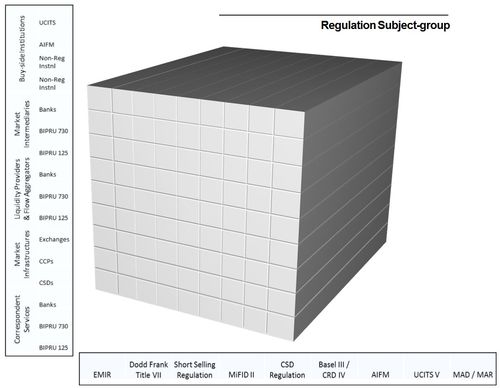
We
had our fifth plenary meeting of the Clearing & Settlement Working Group
(CAS-WG) in March.
The meeting covered all the latest
issues, news and views, and was kicked off by Greg Caldwell, Chair of the
Regulations Subject Group, who outlined the complexity of European and Global
Regulations through this slide outlining the Rubik’s Cube of Regulations.
Between
EMIR (the European Markets Infrastructure Regulation), Dodd-Frank, MiFID II
(the Markets in Financial Instruments Directive), CRD IV (Capital Requirements Directive),
MAD (Markets Abuse Directive) and more, the regulatory landscape is changing
and complex.
There is an awful lot of overlap and
conflict between directives across regions.
For example, just look at Dodd-Frank
versus EMIR where there are distinct differences and conflicts between
confirmations, client documentation, portfolio reconciliation and compression
requirements as demonstrated by this paper published in November 2012 by
Clifford Chance:
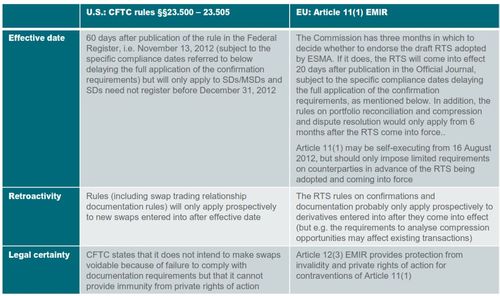
Greg concluded by saying that the primary
value-add of the Regulations Subject Group will be to identify opportunities
for financial institutions to avoid unnecessary costs or, as he terms it, avoid
‘digging up the road more than once’.
This is the focus of a crowdsourcing
initiative to get ideas as to where there are conflicts and overlaps
in regulations. Anyone with a view should send these views to kamila@fsclub.co.uk or greg@gregorycaldwell.com , with one entry to be picked at
random for a free membership to the Financial Services Club.
Greg was followed by a fascinating presentation
by Ben Parker, Head of Clearing & Settlement for UBS, on the likely path of
T2S (TARGET2 for Securities) and whether it’s a good or bad thing.
Ben began by talking about when he
first saw the details of T2S, and how the ECB had developed the idea of it
after the success of TARGET as a Real-Time Gross Settlement (RTGS) system for
pan-European high value payments.
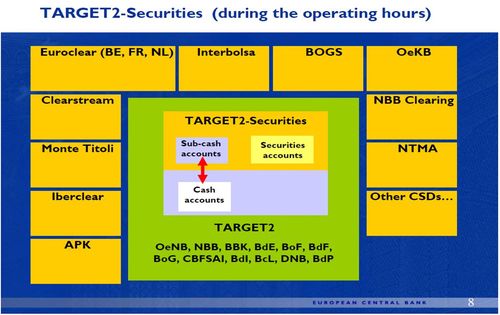
T2S
was spawned back in the early 2000’s as an outcome of the Giovannini Committee,
who found that the barriers to a harmonised European trading market was due, in
large part, to the barriers to cross-border settlement due to member state
laws.
In order to overcome this, the ECB
created T2S.
Ten years later, it’s getting nearer
to launch (it’s still not there yet).
A good idea in principle but, in
practice, it has issues in terms of what this means for the unbundling of
products and services in post-trade between custodians, clearing houses and
securities depositories.
Ben then went to talk about the
elephant in the room.
Is T2S worth it?
Are there going to be any benefits?
Is the end state achievable and,
more importantly, worthwhile?
He put this in the context of UBS
who process nine million trades a year (I assume he means in Europe).
The order size of those trades has
come down but the Custodians costs have gone up. T2S should
reduce those costs as they will be able to consolidate custodial services to a smaller
number of providers.
In
fact, today, UBS are unable to outsource much of their post-trade settlement
services due to the complexity of each member states operations. Post-T2S
the hope is that this will be simplified and so settlement outsourcing to a
sleek and small number of custodial providers will become the norm. That
means that T2S will provide increased efficiencies and capabilities. It will
make settlement a commoditised process and reduce risk, with T+2 a major step
forward.
Good quality collateral is another
key challenge and there is a barrier to optimising collateral when long
positions have to held with multiple custodians in multiple venues.
T2S overcomes some of those issues by allowing the consolidation of custodians.
Ben fully expects that, over time, most of the major players will in fact
move towards a self-settlement environment.
Another issue for Ben is open
trades. Open trades are a nightmare as they could mean that these are failed
trades and therefore open risks. Russia has the most failed trades for
UBS,
closely followed by Portugal.
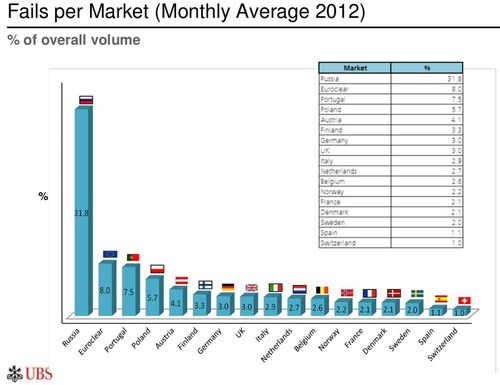
A
third of the open trades are caused by static data. Therefore,
harmonising and standardising
post-trade settlement towards greater real-time analytics will make markets more
efficient.
Admittedly, there will be a
short-term issue of settlement costs rising for many firms but that should be
offset by the longer term reduced costs provided by the move to self-settlement
and consolidated custodial services. Although this idea of unbundling securities
from asset servicing is nothing new, the idea of getting the benefits of consolidation
and self-service is key.
Then there is the issue of
cost. Many have complained about the cost of T2S, which is estimated to
be north of €1.5 billion by some. But the banks should not have to absorb
that cost as most of this will be taken by the custodians. Sure, the
custodians will pass on that cost to the customer but, as customers consolidate
custodians, they will reduce costs over time so it is worth the cost.
The only other issue is the one of
who’s in and who’s out. After all, 40% of the trading in the UBS operations
are in the UK and the UK is not part of T2S. That is another key issue.
However, all in all, the cost and fragmentation
is not as big an issue as the opportunity to move to self-servicing and consolidation.
So there are challenges but also major benefits for UBS in the move to T2S.
Ben was followed by an update from
our other two subject groups – the Market Infrastructure Subject Group, chaired
by Kathleen Tyson-Quah, and the Technology Standards Subject Group co-chaired
by Virginie O’Shea and Graeme Austin.
Kathleen made clear that their group
is facing a funding challenge. They believe they have hit
upon a fantastic idea to map the trade flows between execution venues, CCPs, CSDs
and markets, but need funding to build the model into reality.
The straw model is already live at http://emiit.info/ and the group is now seeking
investment from interested parties to build this into a realistic system.
It was interesting to note that this
would really help the regulators as well as the providers, as Kathleen was recently
with one bank who produce 23,000 risk management reports globally every
day. The bank recently found that, of those reports, 85% are never
actually reviewed or read.
Do regulators
read the reports they receive? Probably not but, by having a tool that
can
show them trade flows across markets in real-time, they would have the tools to
concentrate the mind.
This is why Kathleen’s group are making
their next step to present the trade flow tool to the Financial Stability Board
and the Prudential Regulatory Authority, to see what appetite the regulator has
for these tools.
The final presentation was from
Virginie O’Shea on Technology Standards.
Virginie
talked about various activities in the Technology Standards Group, with the aim
of clarifying the connectivity and interconnectivity of CCPs, CSDs and ICSDs,
as well as T2S.
Equally,
with co-chair Graeme Austin, Virginie made it clear that the Group is
co-ordinating key dialogues with SWIFT, FIX, ISISTC and AFME to identify areas
of correlation and overlap, and to ensure clarity of focus upon trade and trade
confirmation areas.
One
of the biggest areas the Group feels it can contribute and develop knowledge
around is the technology standards investment roadmap.
The
Investment Roadmap affirms the commitment of
the various standards organisations – FIX, FpML, SWIFT, XBRL, ISITC and
FISD – to ISO20022.
It
was notable from the work of the Technology Standards Group that some of the
standards bodies are more committed than others, as there is still some work to
be done to achieve ISO20022 conformance in a number of areas.
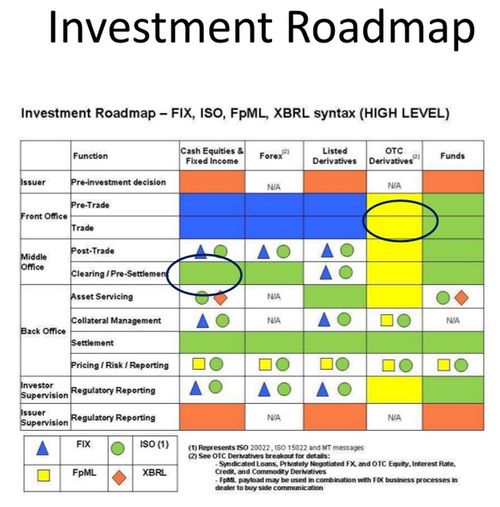
The
plenary finished with a debate between Martin Watkins of Ernst & Young, Bob
Fuller of Fixnetix and Andrew Simpson, Market Infrastructures Consultant, about
the merits of the European landscape today, in the context of EMIR and other regulations.
It was a fascinating debate and one
that I will write up separately as it merits its own space.
So, watch this space for a view on
where European regulations are going right now (not including Cyprus of
course).
In
the meantime, here are the slides from the session for those who like this sort
of stuff:
Chris M Skinner
Chris Skinner is best known as an independent commentator on the financial markets through his blog, TheFinanser.com, as author of the bestselling book Digital Bank, and Chair of the European networking forum the Financial Services Club. He has been voted one of the most influential people in banking by The Financial Brand (as well as one of the best blogs), a FinTech Titan (Next Bank), one of the Fintech Leaders you need to follow (City AM, Deluxe and Jax Finance), as well as one of the Top 40 most influential people in financial technology by the Wall Street Journal's Financial News. To learn more click here...

